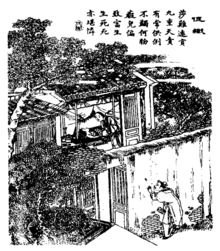The Fighting Cricket
"The Fighting Cricket" (simplified Chinese: 促织; traditional Chinese: 促織; pinyin: Cùzhi) is a short story by Pu Songling first published in Strange Tales from a Chinese Studio. Set in a society whose emperor has an obsession with fighting crickets, the story follows a boy who metamorphoses into one such cricket to save his father.
| "The Fighting Cricket" | |
|---|---|
 19th-century illustration from Xiangzhu liaozhai zhiyi tuyong (Liaozhai Zhiyi with commentary and illustrations; 1886) | |
| Author | Pu Songling |
| Original title | "促织 (Cuzhi)" |
| Country | China |
| Language | Chinese |
| Genre(s) | |
| Published in | Strange Tales from a Chinese Studio |
| Publication date | 1740 |
| Preceded by | "Gongsun Jiuniang (公孙九娘)" |
| Followed by | "Liu Xiucai (柳秀才)" |
Publication history
The story was originally titled "Cuzhi" (促織) and first appeared in Pu Songling's anthology of supernatural tales, Strange Tales from a Chinese Studio (Liaozhai) published in 1740. It was first translated into English as "The Fighting Cricket" by the British sinologist Herbert A. Giles and was included in his 1880 translation of Strange Tales. It reappeared with modifications in a subsequent edition, published in 1908.[1]
Inspiration
Cricket fighting was commonplace during the Qing dynasty which Pu lived in, with established clubs in the more developed cities like Beijing, Tianjin, and Shanghai. Pu evidently drew some inspiration from the Ming dynasty guidebook to Beijing titled A Brief Guide to Sights in the Capital, having published a condensed version of it with a foreword of his own. Technical details found in A Brief Guide, like the diet of a cricket and the different types of cricket, are incorporated in Pu's short story, while other phrases in the guidebook are copied verbatim. Pu's "connoisseurship" and the influence of specialised handbooks on him can also be seen in another Strange Tales story titled "A Strange Matter Concerning Pigeons" which revolves around pigeons instead of crickets.[2]
Themes and analysis
Adrian Hsia argues that in "The Fighting Cricket", Pu is rallying against the unfair treatment of the peasants that he would have personally witnessed: "The fighting cricket is a sign of the inhuman exploitation through taxes which can destroy every family."[3] He likens the story to "The Metamorphosis" by Franz Kafka, pointing out that both works "create, through their animal figures, an artistic world which is parallel to the human world"[4] while adding that the "affinity" between the two stories was "striking" to Chinese critics.[5]
References
Citations
- Giles 2011, p. 254.
- Zeitlin 1997, pp. 71–72.
- Hsia 1996, pp. 150–155.
- Hsia 1996, p. 175.
- Hsia 1996, p. 192.
Bibliography
- Giles, Herbert A. (2011) [1878]. Strange Tales from a Chinese Studio: The Classic Collection of Eerie and Fantastic Chinese Stories of the Supernatural. Clarendon, Verm.: Tuttle Publishing. ISBN 9781462900732.CS1 maint: ref=harv (link)
- Hsia, Adrian (1996). Kafka and China. Lang. ISBN 9783906755830.CS1 maint: ref=harv (link)
- Zeitlin, Judith T. (1997). Historian of the Strange: Pu Songling and the Chinese Classical Tale. Palo Alto: Stanford University Press. ISBN 9780804729680.CS1 maint: ref=harv (link)